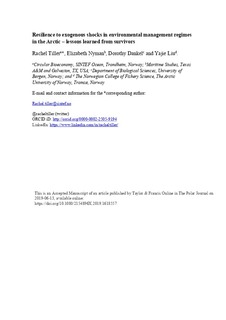| dc.description.abstract | A changing climate will impact not only the environment but all levels of governance thereof, including the context of the close to 400 multilateral environmental management agreements signed since the year 2000. For the Ocean, researchers project that the increasing sea surface temperatures will facilitate large changes in the marine food web, including large shifts in distribution patterns of marine life towards the north and cooler waters. These new distributions of marine resources have political consequences. But to what extent will these climatic stressors act as an external "shock" to existing management regimes in the Arctic? How resilient are the current Arctic management regimes? We illustrate these questions with a particular on-going case of the sharing of the Northeast Atlantic mackerel quota. The negotiation difficulties among Norway, the EU, Faroe Islands, Iceland, Greenland and Russia initiated by the the vast expansion its distribution pattern gives us a hint of what is to come if business-as-usual scenarios of the International Panel on Climate Change (IPCC) come to pass. We further focus our analysis on the Svalbard Fisheries Protection Zone, to learn from other environmental management regimes that have lived through exogenous shocks. Finally, we discuss the impact exogenous shocks have had on three different environmental management regimes: the impact of the ozone hole on the ozone regime, the impact of Black Forest death (“Waldsterben”) on the Convention on Long-range Transboundary Air Pollution, and the impact on Regional Fisheries Management Organizations of the creation of Exclusive Economic Zones under the United Nations Convention on the Law of the Sea. | nb_NO |

